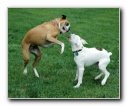|
Timid Shy Dog
While some dogs are boisterous, outgoing and brave. Others can be a more timid shy dog. Like people, each dog has their own personality, it may be a matter of genetics (nature), or learned through their life experiences (nurture). Whether it’s nature, nurture, or a combination of both, you can help your timid shy dog overcome this disorder, and become more confident in his or her capabilities. Dogs who are skittish or fearful can often suffer from behavior problems such as separation anxiety, excessive barking, or chewing If fears escalate, these pets can sometimes become fear biters… they may show aggressive behaviors feeling they need to defend themselves from the perceived threat.

In milder cases, this dog simply misses out on lots of the fun! Instead of being petted by dog loving visitors, they choose to hide in a corner. Instead of enjoying visits to a nearby park or wrestling around with other dogs, they may cower or totally avoid any interactions. If your dog is timid or shy, you can help your pet by using some obedience training, socialization, and confidence building exercises. By working on basic commands, you’ll have the opportunity to praise your dog for learning something new. This can be just the right confidence builder they need. Agility can also boost confidence. Learning to jump, climb or weave, (exercises they would have never taken part in before), can really help skittish dogs to become more self-assured.
Last, but very important for safety reasons, never try to pet your timid shy dog while they're afraid. For example, if you pet your dog while he’s acting timid or shying away from a visitor, he’ll become confused and think you’re praising him for acting in that manner. He will certainly not feel comforted or soothed. Instead, gently tell him "No", and get his concentration off what he thinks is threatening, help him to behave more naturally by giving some obedience commands, involve him in a game of playing ball, or some other common activity he enjoys. Praise your dog only after he’s acting more relaxed, encourage him to receive a treat, or to be touched by your friend.
Return to Dog Training Tips
|






